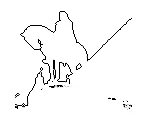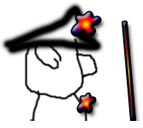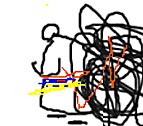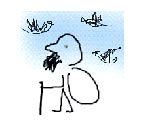Living Monuments of Cluj-Napoca, Romania
by Carmen Belean
November, 2003 Cluj, Romania

Rural masses form cultures we ultimately call the city, but in observing a single niche about any downtown area one can always go beyond the surface to discover a group of durable individuals, going about their livelihoods. Like any international city, Cluj-Napoca, Romania too has countless facets and faces. Observe the relationship of an inhabitant to his environment and the perception of that city takes on a fresh dynamic. Beyond the concrete and flow of masses, expressions of individuals may then emerge. The outsider might then be confronted with appearances of some one instinctively would call peculiar, odd or even “mad”.

Take for example the “General” of Cluj: He is easily distinguishable among the citizenry by his extreme retort to people that he passes along the way. He’s obsessed with always being in command, and his crave for power and superficial decoration is perhaps a common mania of most rulers. You can see him parading throughout the city with his canine crossbreed, wearing his usual smutty green army jacket adorned with display of decorations and medals. However fake, he’s perhaps most conspicuous by the ominous gun he lugs, for no good general can be complete without his weapon. Somewhere between his incongruent self-depiction and true inner conscious lays the truth of us all. For the populace of Cluj he will always remain the General, although poetically, he might be dubbed the metaphor of the officer who lost his army, and perhaps even the war, but nevertheless continues his battle. One day the General and I crossed paths, our eyes fixing in passing. He reacted immediately, took his gun and waved it two inches from my face, all the while exclaiming: “I’ll shoot you”. Well he didn’t, and I continue to live to tell this tale.

In the meantime another character frequents the stage of urban perceptions. A peculiar elderly woman has arrived on the scene, who always has large nylon bags in tow wherever she goes. Her body is wrapped in a worn-and-torn red waistcoat, bound in waistbands of the national tri-colors. For that reason I affectionately distinguish her as the “Garbage Woman”, not because she’s so soiled, but because she is forever collecting and hauling her prizes from place to place. From my point of view she stands for society’s fixation with collecting needless things, to make up for their emotional emptiness, and most ironically, just to feel rich. In shy recoil she lets no one near; nonetheless she is a part of each and every one of us - a part of this city called Cluj.

“Bird Man" is a more frequent character about the city center. He is indeed as much an attraction for any tourist as is the central square he thrives about. On a foggy day near the Mathias Cathedral his very appearance on the scene might seem surrealistic, much like a mystical character from a storybook, statuesque with a thick grey beard, a knapsack, and a cane in hand, as he watches over his enormous flock of birds, day in and day out. At times he conjures the picture of a large mound of moving feathers that suddenly scatter to reveal the cheerful soul of a human being. In such affinity of man and bird, who should wonder if some day he spread his own wings and flew off into the vanishing sunset?

Anyone would recognize the “Tailor Man”, an elderly gentleman elegantly clothed standing near some quiet corner in his permanent suit of black; that is, his suit used to be black. Now most of his attire is indiscriminately stitched over with white thread. I recall how years ago hardly any white had ever been visible in his garment. Only now, as he’s grown older, have the stitches grown too. Now the larger part of his slacks has now become completely white because of the stitches. The “Tailor Man” always dons a smile and and extends the time of day. He is noticeably courteous in passing in contrast to the “General” or the “Garbage Woman”.
Standing silently on the city sidewalks the Tailor Man’s face reflects the serenity of a person who has little left to loose, perhaps in recognition of his deteriorating vigour. By all observation he is at peace with himself, somewhere above the bickering and moaning engulfing the city. With artistic whim I imagine the stitches mummifying his whole body up until he takes his final breath, signalling transcendence to the world beyond. Each of the aforementioned characters is truly distinct, and set themselves apart from the crowd. In doing this they paradoxically fit best into the weave from which they are also excluded. Thus, by not conforming to the homogenous picture of the city they fit best. Indeed they are the soul of the city, drawing attention to elements that people usually care to forget. By noticing how they are different attention is called to human traits that people all have in common. In other words, being different makes a difference. I’ve discovered this town in a way that I’d never realized before. In combing familiar streets for new details I sometimes catch myself observing my own self in the act of observing; not in passing judgment of what should be respectable or not, but to pay silent tribute to a few noble figures such as these as long as they continue to be among us. They’re perhaps the last of an outgoing era.